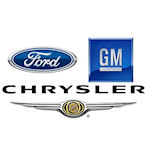Bailout or Bankruptcy: Potential Consequences of Letting the Big 3 Go Bust
 GM, Ford, and Chrysler are all clamoring to be next in line to receive billions of dollars of taxpayer money. Should they get it? If they don’t, will bankruptcy lead to the economic catastrophe recently forecasted by Big 3 executives on Capital Hill?
GM, Ford, and Chrysler are all clamoring to be next in line to receive billions of dollars of taxpayer money. Should they get it? If they don’t, will bankruptcy lead to the economic catastrophe recently forecasted by Big 3 executives on Capital Hill?
Absent a bailout, the Big 3 are looking at Chapter 11 bankruptcy. Chapter 11 is a corporation-specific type of bankruptcy that calls off the dogs and gives a company breathing room to restructure. In the case of the big 3 automakers, most experts agree that Chapter 11 bankruptcy would cut jobs, gut costly labor contracts with unions such as UAW, eliminate pension obligations to current and future retirees, and close unproductive factories.
Although shedding billions in health care costs, pension benefits, and operating costs might look good for a company’s balance sheet, the picture is not so rosy for everyone else. The UAW was a major supporter of President-elect Obama and will not be pleased if the democratic government they helped elect turns their back on them. Furthermore, where will they go for health care? Many-especially those who will inevitably lose their jobs-will go to Medicaid.
Then there are pension benefits. What happens when a company like GM can’t make its pension obligations? Under the Pension Benefit Guaranty Corporation, the federal government insures pension plans in the American auto industry; this agency is already $14 billion in debt.
Lastly, one of the most important parts of corporate restructuring under Chapter 11 is debtor-in-possession financing. This allows a bankrupt corporation to take loans to stay afloat, with the creditors of the needed capital jumping to the front of the claims line. With the economy in a tailspin and credit lines essentially non-existent however, economists like Nobel Prize winning Paul Krugman worry that no one will make any loans. No loans means no production; no production means this turns into a Chapter 7 liquidation.
No one wants to see what will happen if the big 3 simply cease to exist. Experts predict that the potential ripple effect would cost 2.5 million jobs in the various industries that depend on companies like GM. Many unemployed would inevitably end up in government unemployment lines.
There is no question that fundamental restructuring needs to be done. Some job loss and benefit cutting is inevitable. A bailout with strict conditions similar to a bankruptcy hearing, however, could prevent a far larger potential catastrophe. The government’s loan would operate similar to debtor in possession financing necessary to keep the production lines rolling and save millions of American jobs. Significant strings could be attached: the Big 3 would need to do major restructuring of their labor contracts, close unproductive plants, get rid of incompetent management, and make fundamental changes to their business model. Some creditors may need to take a significant pay cut or agree to restructure their claims. At the same time, some of the more horrific consequences of liquidation and massive unemployment would be avoided, and at a fraction of the cost to our economy should the big 3 all go bust.
Just like the original bailout, none of the options look good. Sometimes, however, you have to pick the lesser of two evils.


Comments